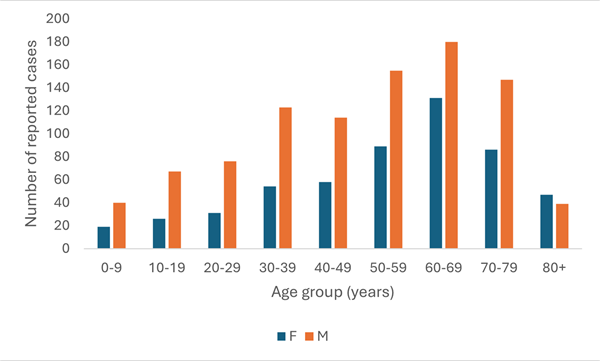Tickborne Diseases

Tickborne diseases are caused by infectious agents transmitted by tick bites. Individuals who have been bitten by a tick may not feel it, it is important to check yourself for ticks after spending time outdoors. If you find a tick attached to your skin, it may have fed and transmitted an infectious agent. If you find a tick attached to your skin, you should remove it and tell your healthcare provider about your recent tick bite.
How to remove a tick: Tick Removal and Testing (CDC)
- Use tweezers to grasp the tick as close to the skin’s surface as possible
- Pull upward without twisting the tick
- Clean the bite area and your hands with rubbing alcohol or soap and water
Do not crush a tick with your fingers. Dispose of a live tick by
- Putting it in rubbing alcohol
- Placing it in a sealed bag or container
- Wrapping it in tape, or
- Flushing it down the toilet
 The Pennsylvania Department of Environmental Protection’s Tick Surveillance and Testing Program conducts statewide tick surveillance to determine the distribution, prevalence and expansion of tick populations throughout the state. The Program tests ticks for pathogens that can impact human health. Ixodes scapularis (Blacklegged or Deer Tick), ticks can transmit Lyme disease as well as other tickborne illnesses, the Program focuses mainly on this species, pictured below. Other ticks that are frequently collected include Dermacentor variabilis (American Dog tick), Amblyomma americanum (Lonestar tick), Haemaphysalis longicornis (Asian Longhorned tick) and Amblyomma maculatum (Gulf Coast tick).
The Pennsylvania Department of Environmental Protection’s Tick Surveillance and Testing Program conducts statewide tick surveillance to determine the distribution, prevalence and expansion of tick populations throughout the state. The Program tests ticks for pathogens that can impact human health. Ixodes scapularis (Blacklegged or Deer Tick), ticks can transmit Lyme disease as well as other tickborne illnesses, the Program focuses mainly on this species, pictured below. Other ticks that are frequently collected include Dermacentor variabilis (American Dog tick), Amblyomma americanum (Lonestar tick), Haemaphysalis longicornis (Asian Longhorned tick) and Amblyomma maculatum (Gulf Coast tick).
The Allegheny County Health Department Vector Control Program offers tick identification services to county residents. To receive more information, please call the ACHD Housing and Community Environment Program at 412-350-4046.
Lyme Disease
Lyme disease cases are now counted based on positive laboratory results reported to the health department. Given that many people are diagnosed and treated by their healthcare provider without a laboratory test, there are likely many more cases occurring in the county than are reported to the Health Department.
Of 1,485 cases reported in 2023, 941 (63%) were male and 59% were >50 years (Figure 1).
Figure 1. Lyme disease cases by age group and sex, Allegheny County, 2023

Lyme disease cases occurred throughout the county. Cases identified from 2021 through 2023 are shown below by place of residence (Figure 2).
Figure 2. Reported Lyme disease cases by place of residence, 2021-2023
Lyme disease cases occurred throughout the county. Confirmed and probable cases identified between 2020-2022 are shown below by place of residence (Figure 3).

Anaplasmosis
Anaplasmosis is caused by the bacterium Anaplasma phagocytophilum and is transmitted by the blacklegged tick Ixodes scapularis, the same tick that transmits the Lyme disease bacterium. Signs and symptoms of anaplasmosis include fever, chills, headache, muscle aches, fatigue, nausea, vomiting and abdominal pain. If left untreated, anaplasmosis can cause severe illness including bleeding problems, respiratory failure and organ failure.
Reported anaplasmosis cases have been increasing in Allegheny County during the past few years (Figure 3). Similar to Lyme disease, positive test results are reported to the Health Department by laboratories.
Figure 3. Anaplasmosis cases by year, 2014-2023

Other Tickborne Diseases
In 2023 in Allegheny County, two cases of babesiosis, which is caused by a parasite that is also transmitted by the black-legged tick, were reported. One case of ehrlichiosis, a bacterial infection transmitted by the same tick species, was reported.
Tickborne Disease Prevention
While ticks are most active in warmer months (April through October), they can emerge any time temperatures are above freezing. Prevention measures include avoiding wooded and brushy areas, using repellants with DEET for skin or permethrin for clothing and shoes, showering after being outdoors, checking for ticks and removing ticks as soon as possible.
For additional information on Lyme disease and other tickborne diseases, see the resources listed below.
Resources
CDC
Pennsylvania Department of Health (includes information for schools and camps)
Pennsylvania Department of Environmental Protection
Allegheny County Health Department Vector Control Program